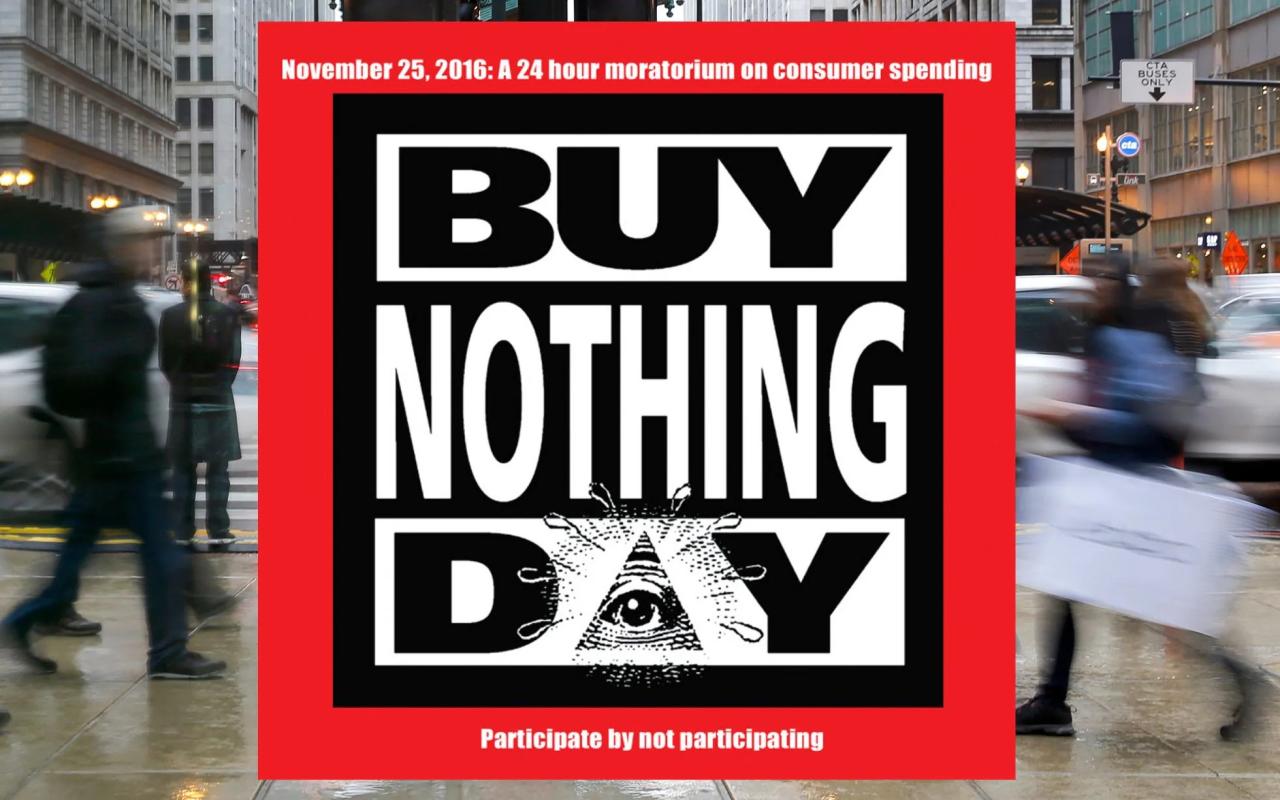Buy nothing day ap lang – Embark on a journey with Buy Nothing Day, a global movement that challenges the rampant consumerism that plagues our society. Join us as we delve into its origins, principles, and profound impact on the way we live and consume.
Buy Nothing Day is a day of conscious reflection, where we abstain from all purchases, recognizing the detrimental effects of mindless consumption. It’s a testament to the growing awareness of environmental degradation and social inequality, inspiring individuals and communities to make a positive change.
Buy Nothing Day Origins and History

Buy Nothing Day originated in 1992 as a response to the excessive consumerism associated with the holiday season. Its founders, Ted Dave and Kalle Lasn, aimed to raise awareness about the negative environmental and social impacts of rampant consumption.
Evolution of Buy Nothing Day
Over the years, Buy Nothing Day has evolved from a one-day event to a broader movement that encourages mindful consumption and promotes alternative ways to connect with others.
- 1990s:Focus on raising awareness about overconsumption.
- 2000s:Expansion to include a wider range of activities, such as community-building events and gift-giving alternatives.
- 2010s:Growing emphasis on environmental sustainability and social justice issues.
Buy Nothing Day Principles and Practices

Buy Nothing Day, observed annually on the day after Thanksgiving in the United States, is a global event that encourages people to refrain from making any purchases for a 24-hour period. The event aims to promote mindful consumption and reduce the environmental impact of consumerism.
The core principles of Buy Nothing Day include:
- Refuse unnecessary purchases:Participants are encouraged to avoid making any purchases that are not essential for their survival or well-being.
- Reduce waste:Buy Nothing Day encourages people to reduce the amount of waste they produce by purchasing less and repairing or reusing items whenever possible.
- Support sustainable businesses:Participants are encouraged to support businesses that prioritize sustainability and ethical practices.
- Promote community:Buy Nothing Day is an opportunity for communities to come together and engage in non-consumerist activities, such as volunteering or spending time with loved ones.
Individual Participation, Buy nothing day ap lang
Individuals can participate in Buy Nothing Day by simply refraining from making any purchases for 24 hours. This can be a challenging but rewarding experience that helps people to become more mindful of their consumption habits.
Community Participation
Communities can participate in Buy Nothing Day by organizing events and activities that promote the principles of the event. These events can include workshops on sustainable living, community clean-ups, or potlucks where people can share food and conversation.
Benefits and Challenges
Observing Buy Nothing Day can provide several benefits, including:
- Reduced spending:Participants can save money by avoiding unnecessary purchases.
- Increased mindfulness:Buy Nothing Day encourages people to be more mindful of their consumption habits.
- Reduced environmental impact:By purchasing less, participants can reduce their carbon footprint and support a more sustainable future.
However, there are also some challenges associated with observing Buy Nothing Day, including:
- Social pressure:Participants may face social pressure from friends and family who do not understand or support their decision to refrain from making purchases.
- Convenience:It can be difficult to avoid making purchases in a society that is constantly pushing consumerism.
- Essential purchases:Participants may need to make essential purchases, such as food or medicine, during the 24-hour period.
Buy Nothing Day and Consumerism

Buy Nothing Day stands as a stark counterpoint to the relentless consumerism that characterizes modern society. It challenges the notion that consumption is synonymous with happiness and fulfillment and encourages individuals to critically examine their purchasing habits.
Impact on Consumer Behavior
- Reduced Consumption:Buy Nothing Day encourages participants to abstain from purchasing non-essential items, leading to a noticeable decrease in consumer spending.
- Increased Awareness:By highlighting the environmental and social costs of excessive consumption, Buy Nothing Day raises awareness about the impact of consumer choices.
- Promotes Mindful Consumption:Buy Nothing Day encourages consumers to make conscious decisions about their purchases, considering the necessity and sustainability of each item.
Challenging Traditional Notions of Consumption
Buy Nothing Day challenges the traditional belief that consumption is essential for economic growth and personal well-being. It argues that rampant consumerism leads to environmental degradation, social inequality, and a sense of emptiness.
- Economic Growth:Buy Nothing Day demonstrates that economic growth is not solely dependent on consumer spending. It highlights the importance of sustainable practices and alternative economic models.
- Personal Fulfillment:Buy Nothing Day encourages individuals to find fulfillment in experiences, relationships, and personal growth rather than material possessions.
Promoting Sustainable Practices
Buy Nothing Day has the potential to promote sustainable practices by reducing waste and encouraging responsible consumption.
- Waste Reduction:By abstaining from unnecessary purchases, Buy Nothing Day helps reduce waste associated with packaging, manufacturing, and disposal.
- Environmental Conservation:Buy Nothing Day promotes the conservation of natural resources by reducing the demand for products that require extraction and processing.
- Community Building:Buy Nothing Day encourages community building by fostering a sense of shared purpose and encouraging people to engage in local exchange and repair networks.
Buy Nothing Day and the Media

The media has played a significant role in raising awareness and shaping public opinion about Buy Nothing Day. Over the years, the day has received coverage from various media outlets, including newspapers, magazines, television, and online platforms.
Media Coverage of Buy Nothing Day
The media has generally presented Buy Nothing Day in a positive light, highlighting its potential to promote sustainable consumption and reduce environmental impact. Many articles and reports have focused on the benefits of reducing consumption, such as saving money, reducing waste, and supporting local businesses.
The media has also featured interviews with individuals and organizations involved in Buy Nothing Day, providing personal perspectives and insights into the movement.
Different Perspectives on Buy Nothing Day
While the media has generally been supportive of Buy Nothing Day, there have also been some dissenting voices. Some commentators have argued that the day is too extreme and impractical, and that it ignores the economic benefits of consumer spending.
Buy Nothing Day, an event advocating against rampant consumerism, encourages us to reconsider our shopping habits. While we may not all become instant minimalists, it’s worth exploring alternative perspectives on consumption. Take p r o f i t unscramble , for instance.
Understanding the underlying mechanisms of profit-driven economies can help us make more conscious choices as consumers, aligning with the spirit of Buy Nothing Day.
Others have expressed concerns that Buy Nothing Day could lead to a decline in charitable giving, as people may be less likely to donate if they are not buying anything.
Role of the Media in Shaping Public Opinion
The media plays a crucial role in shaping public opinion about Buy Nothing Day. By providing information and perspectives on the day, the media can influence how people understand and engage with the movement. Positive media coverage can help to raise awareness and encourage participation, while negative coverage can discourage people from getting involved.
The media also has the potential to influence the way that policymakers and businesses view Buy Nothing Day, which can have a broader impact on its impact and effectiveness.
Buy Nothing Day and Social Change: Buy Nothing Day Ap Lang
Buy Nothing Day holds the potential to inspire significant social change by fostering awareness, community, and equality.One crucial aspect of Buy Nothing Day is its ability to raise awareness about environmental issues. By encouraging individuals to refrain from consuming for a day, it highlights the environmental toll of excessive consumption and prompts reflection on sustainable practices.
This awareness can lead to long-term changes in consumer behavior, promoting eco-friendly choices and reducing the strain on natural resources.Furthermore, Buy Nothing Day fosters community and reduces inequality by encouraging people to engage with their neighbors and local businesses. By participating in community events, exchanging goods and services, and supporting local businesses, individuals strengthen social bonds and contribute to a more equitable society.
Buy Nothing Day challenges the isolation and individualism often associated with consumerism, fostering a sense of collective responsibility and mutual support.
Top FAQs
What is the purpose of Buy Nothing Day?
Buy Nothing Day aims to challenge consumerism, raise awareness about environmental issues, and promote sustainable practices.
How can I participate in Buy Nothing Day?
Simply refrain from making any purchases on Buy Nothing Day and engage in activities that promote sustainability, such as repairing items, sharing resources, or volunteering.
What are the benefits of observing Buy Nothing Day?
Buy Nothing Day can help reduce waste, promote mindful consumption, foster community, and raise awareness about environmental and social issues.